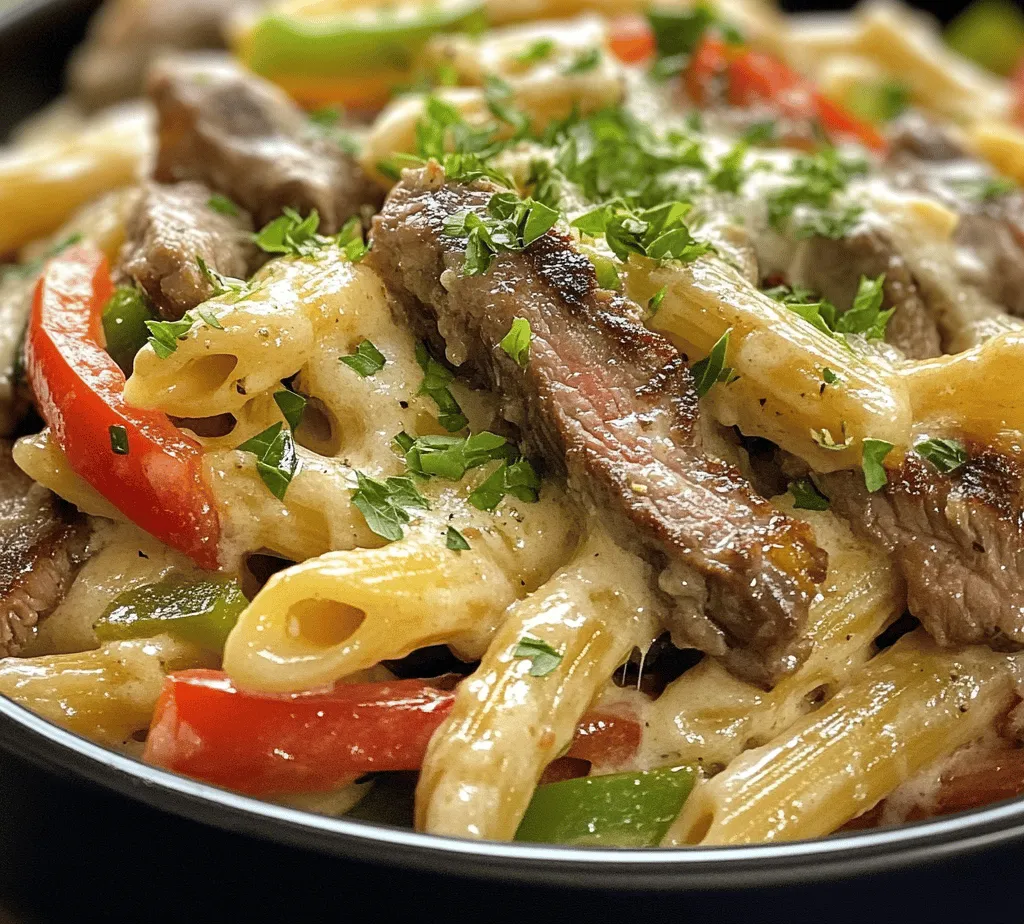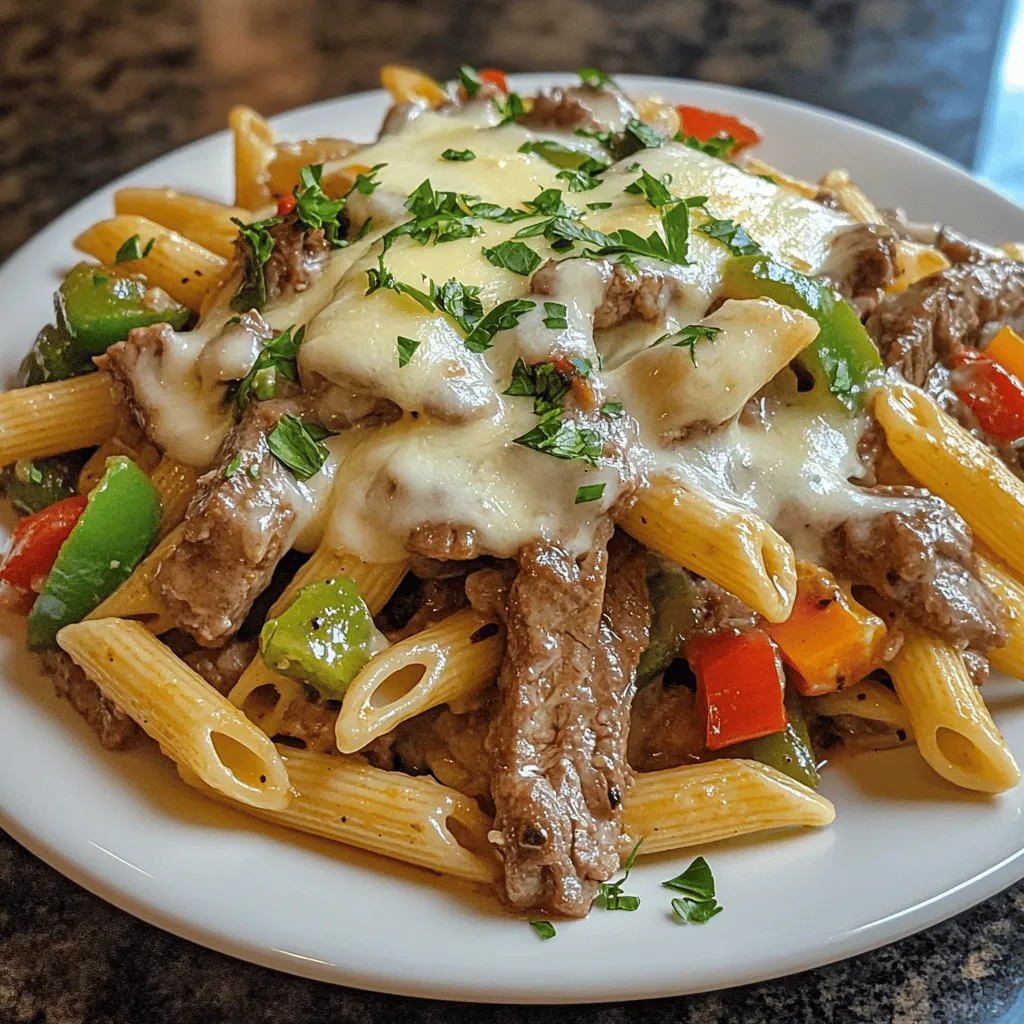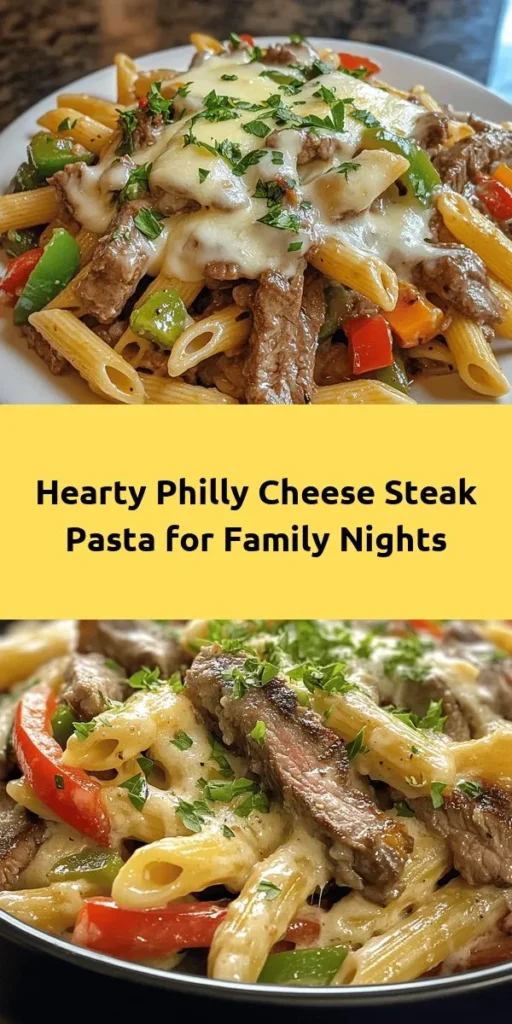Introduction
In the realm of comfort food, few dishes can rival the rich, savory flavors of a classic Philly cheesesteak. This iconic sandwich, originating from the streets of Philadelphia, combines thinly sliced ribeye steak with melted cheese, sautéed onions, and peppers, all nestled between a soft hoagie roll. But what if we could take all those beloved flavors and transform them into a hearty pasta dish that’s perfect for family dinners? Enter the Delicious Philly Cheese Steak Pasta recipe, where tender ribeye steak meets vibrant vegetables and a creamy cheese sauce, all tossed with al dente penne pasta.
This innovative dish captures the essence of the traditional cheesesteak while offering the comfort of a pasta meal. Whether you’re hosting a family gathering or simply looking for a weeknight dinner that pleases everyone at the table, this recipe is sure to impress. In this article, we will guide you step-by-step through the creation of this mouthwatering dish while also delving into the fascinating history of Philly cheesesteaks, the nutritional benefits of the ingredients, and expert tips for achieving a satisfying meal.
Understanding the Origins of Philly Cheesesteak
The Philly cheesesteak has a storied history that dates back to the early 20th century. It is believed to have been invented by Pat Olivieri, a hot dog vendor in Philadelphia, who decided to grill some beef on his hot dog stand one day. The aroma of the cooking meat attracted a cab driver, who asked for a sandwich made from the beef. This chance encounter led to the creation of a culinary staple that would soon become synonymous with Philadelphia itself.
Over the decades, the cheesesteak grew in popularity, becoming a beloved street food among locals and tourists alike. It is not just a meal; it is a symbol of Philadelphia’s culinary culture, often debated among residents as to which establishment serves the best version. Today, the cheesesteak is a fixture in the city’s landscape, with numerous shops and eateries devoted solely to perfecting this classic sandwich.
Transitioning from the sandwich to pasta may seem unconventional, but it offers a delightful twist on a cherished recipe. By reimagining the cheesesteak as a pasta dish, we can explore new textures and flavors while maintaining the hearty essence that makes the original so beloved. This adaptation allows for a more filling meal, making it an ideal choice for family dinners.
Ingredients Breakdown for Philly Cheese Steak Pasta
To create our Delicious Philly Cheese Steak Pasta, we’ll need a selection of high-quality ingredients that not only enhance the dish’s flavor but also contribute to its nutritional value. Below is a detailed analysis of the key components that make this recipe a standout.
The Role of Ribeye Steak: Why It’s the Best Choice
When it comes to cheesesteak, ribeye steak is the undisputed champion. Known for its marbling and rich flavor, ribeye provides a juicy and tender bite that is essential for replicating the authentic cheesesteak experience. The marbled fat in the ribeye melts during cooking, infusing the pasta with a savory essence that elevates the entire dish.
To prepare the steak, it is best to slice it thinly against the grain before cooking. This technique helps to ensure that each piece remains tender and easy to chew, making it a perfect addition to our pasta. For an even more flavorful experience, consider marinating the steak in a blend of Worcestershire sauce and spices before cooking.
The Importance of Fresh Vegetables: Onions, Bell Peppers, and Garlic
A classic Philly cheesesteak wouldn’t be complete without the inclusion of sautéed onions and bell peppers. These vegetables not only contribute a burst of color but also add layers of flavor to the dish. Onions, when caramelized, bring a natural sweetness that balances the richness of the steak and cheese.
Bell peppers, available in a variety of colors, provide a satisfying crunch and a hint of sweetness. For our pasta dish, we recommend using a combination of green and red bell peppers for a visual appeal and a well-rounded flavor profile. Lastly, garlic is a must-have ingredient as it enhances the overall taste and aroma of the dish.
Cream Cheese and Provolone: Creating a Creamy Texture
A key feature of our Philly Cheese Steak Pasta is the creamy sauce that envelops the pasta and ingredients. Combining cream cheese and provolone cheese creates a deliciously smooth texture that mimics the melted cheese found in the traditional cheesesteak.
Cream cheese adds a rich creaminess that binds the ingredients together, while provolone brings a distinctive flavor that is both sharp and nutty. To achieve the best results, allow the cream cheese to soften at room temperature before mixing it with the other ingredients. This will make it easier to blend into the sauce, ensuring a silky consistency that clings to the pasta perfectly.
The Significance of Seasonings: Worcestershire Sauce, Salt, and Pepper
To bring all the flavors together, the right seasonings are essential. Worcestershire sauce, with its complex blend of tangy, sweet, and savory notes, is a classic companion to beef dishes, and it works wonders in our pasta recipe. A few dashes can enhance the flavor of the steak and add depth to the sauce.
Additionally, salt and pepper are fundamental to seasoning the dish. Be sure to season each layer of the dish as you cook, from the steak to the vegetables, to create a well-balanced flavor profile. Remember that the cheese will also add some saltiness, so adjust your seasoning accordingly.
Nutritional Benefits of the Dish: What Makes It a Hearty Family Meal
This Delicious Philly Cheese Steak Pasta is not only satisfying but also packs a nutritional punch. Ribeye steak is a rich source of protein, essential for muscle repair and growth. The addition of fresh vegetables contributes vitamins and minerals, making this dish a well-rounded meal for the entire family.
Pasta, particularly whole grain options, can provide complex carbohydrates that offer sustained energy. By incorporating these wholesome ingredients, you can create a nourishing dish that is both indulgent and beneficial for your health.
Step-by-Step Guide to Making Philly Cheese Steak Pasta
Now that we have explored the origins and ingredients of our Delicious Philly Cheese Steak Pasta, let’s dive into the step-by-step process of making this delectable dish. The following instructions will guide you through the preparation, ensuring that you achieve perfect al dente pasta and a rich sauce that everyone will love.
Preparing the Penne Pasta: Tips for Achieving Perfect Al Dente
1. Boil Water: Start by bringing a large pot of salted water to a rolling boil. The salt will enhance the flavor of the pasta, so don’t skip this step.
2. Add the Pasta: Once the water is boiling, add the penne pasta. Stir it occasionally to prevent sticking.
3. Cook According to Package Instructions: Follow the cooking time on the package for al dente pasta. Typically, this will be around 10-12 minutes, but it’s essential to taste the pasta a minute or two before the suggested time.
4. Reserve Pasta Water: Before draining the pasta, reserve about a cup of the pasta cooking water. This starchy water can be used later to adjust the consistency of the sauce.
5. Drain and Rinse: Drain the pasta in a colander and rinse it briefly under cold water to stop the cooking process. Set it aside while you prepare the sauce.
With the pasta ready, you’ll soon be on your way to creating a delicious Philly Cheese Steak Pasta that will become a family favorite. Stay tuned for the next part of this article, where we will dive into the cooking process and assembly of this delightful dish.

Sautéing the Steak: Techniques for Tenderness and Flavor
To achieve the perfect Philly Cheese Steak Pasta, the way you cook the steak is crucial. Start by selecting a high-quality cut of meat, such as ribeye or sirloin, which are both known for their tenderness and flavor. It’s essential to slice the steak against the grain into thin strips—this method ensures a tender bite.
1. Preheat Your Pan: Use a heavy-bottomed skillet or a cast-iron pan. Heat it over medium-high heat until it’s hot enough that a droplet of water sizzles on contact.
2. Add Oil: Drizzle a tablespoon of olive oil into the pan. This will help create a nice sear on the steak and lock in moisture.
3. Sear the Steak: Add the steak strips in a single layer, making sure not to overcrowd the pan. This allows for a good sear. Let the meat cook undisturbed for about 2-3 minutes on each side until it develops a golden-brown crust.
4. Season Well: Season the steak with salt and pepper as it cooks to enhance its natural flavors. If desired, add garlic powder or onion powder for an extra layer of taste.
5. Remove from Heat: Once cooked to your desired doneness (medium-rare is often preferred), remove the steak from the pan and set it aside. This step is essential to prevent overcooking, especially since the steak will continue to cook when combined with the pasta and sauce.
Cooking the Vegetables: Balancing Texture and Taste
Next, you’ll want to prepare the vegetables, which play a significant role in adding flavor and texture to your dish. Traditional choices include bell peppers and onions, but feel free to get creative!
1. Sauté the Onions: In the same skillet used for the steak, add a bit more olive oil if necessary. Start with the onions, cooking them over medium heat until they become translucent and slightly caramelized. This usually takes about 5 minutes.
2. Add Bell Peppers: Once the onions are soft, add thinly sliced bell peppers. Cook for an additional 3-4 minutes until they soften but retain a bit of crunch. The slight char from the pan adds depth to the flavor.
3. Incorporate Mushrooms: If you’re using mushrooms, add them after the bell peppers. They will soak up the flavors of the pan and add an earthy taste to your dish. Cook until the mushrooms are tender and their moisture has evaporated.
4. Season the Vegetables: Sprinkle some salt, pepper, and Italian seasoning over the vegetables. This will enhance their natural sweetness and tie the flavors together.
Creating the Creamy Sauce: How to Combine Flavors Effectively
A creamy sauce is what makes this dish truly indulgent. Here’s how to create a rich, flavorful sauce that perfectly complements the steak and vegetables.
1. Make the Roux: In the same skillet, melt 2 tablespoons of butter over medium heat. Once melted, whisk in 2 tablespoons of all-purpose flour. Cook for about 1-2 minutes until the mixture is golden and bubbly. This roux will help thicken your sauce.
2. Add Dairy: Gradually whisk in 1 cup of heavy cream, stirring constantly to avoid lumps. The mixture should start to thicken after a few minutes.
3. Incorporate Cheese: Lower the heat and add in 1 cup of shredded provolone cheese. Stir continuously until the cheese melts completely into the sauce. You can also mix in some grated Parmesan for added flavor.
4. Season the Sauce: Taste your sauce and adjust the seasoning with salt, pepper, and a splash of Worcestershire sauce for a hint of umami.
Mixing It All Together: Ensuring Even Distribution of Ingredients
Once your sauce is ready, it’s time to bring everything together. This step is vital for ensuring each bite of pasta is packed with flavor.
1. Cook the Pasta: In a large pot, cook 12 ounces of your pasta of choice (fettuccine, penne, or rotini work well) according to package instructions until al dente. Reserve a cup of pasta water before draining.
2. Combine Ingredients: In the skillet with the creamy sauce, add the sautéed steak and vegetables. Toss to coat them in the sauce, then add the drained pasta.
3. Mix Thoroughly: Gently fold everything together, adding some reserved pasta water if necessary to loosen the sauce and help it cling to the pasta.
Finishing Touches: The Role of Garnishing with Parsley
Presentation matters, especially when serving a meal to family or guests. Garnishing your dish can elevate its appearance and add a fresh taste.
1. Chop Fresh Parsley: Finely chop fresh parsley and sprinkle it generously over the pasta just before serving. This adds a pop of color and a refreshing herbal note that balances the richness of the dish.
2. Add Extra Cheese: For an extra indulgent touch, consider adding more shredded provolone or grated Parmesan on top.
Serving Suggestions and Pairings
Now that your Delicious Philly Cheese Steak Pasta is ready, it’s time to think about how to serve it. Here are some suggestions to enhance your family dinner experience:
Best Sides to Complement Philly Cheese Steak Pasta
– Garlic Bread: A classic side that pairs beautifully with pasta. The buttery, garlicky flavors of the bread are perfect for soaking up any leftover sauce.
– Caesar Salad: A crisp Caesar salad with romaine lettuce, croutons, and a tangy dressing adds a refreshing contrast to the creamy pasta.
– Steamed Vegetables: Lightly steamed broccoli or green beans can balance the richness of the dish while adding a touch of color to your plate.
Perfect Beverages for the Dinner Table
– Wines: A medium-bodied red wine, such as Cabernet Sauvignon or Merlot, complements the flavors of the steak and cheese well. If you prefer white wine, a Chardonnay can also work nicely.
– Soft Drinks: For a non-alcoholic option, consider serving iced tea or a lemon-lime soda, which can refresh the palate.
Creative Presentation Ideas for Family Dinners
– Layered Serving: Serve the pasta in wide bowls, layering it with extra sauce and garnishing it with parsley and cheese for a restaurant-style presentation.
– Individual Portions: For a special touch, consider plating individual portions in ramekins, topped with cheese and baked until bubbly.
Variations and Customizations
One of the best aspects of any recipe is the ability to customize it to fit your dietary needs or preferences. Here are a few variations to consider:
Vegetarian Alternatives: Substituting Steak with Plant-Based Proteins
– Mushroom Steak: For a hearty alternative, use portobello mushrooms marinated in steak seasoning, then grilled or sautéed.
– Tofu or Tempeh: These plant-based proteins can absorb flavors well and provide a satisfying texture. Sauté them with the same seasoning as you would the steak.
Gluten-Free Options: Choosing the Right Pasta
– Gluten-Free Pasta: Many brands offer gluten-free pasta made from corn, rice, or lentils that can be substituted without sacrificing taste.
– Zoodles: For a low-carb version, spiralize zucchini to create zoodles, which can be sautéed lightly before mixing with the sauce.
Spicing It Up: Adding Heat with Jalapeños or Hot Sauce
If you enjoy a bit of heat, consider adding sliced jalapeños or a few dashes of your favorite hot sauce to the sautéed vegetables. This addition can elevate the dish and give it a unique flavor twist.
Exploring Different Cheese Options: Beyond Provolone
While provolone is traditional, feel free to experiment with other cheeses like mozzarella, gouda, or even pepper jack for a spicy kick. Each cheese will bring its own character to the dish.
Conclusion
In conclusion, this Delicious Philly Cheese Steak Pasta recipe is not just a meal; it’s a culinary journey that brings the beloved flavors of Philadelphia to your dining table. With its creamy texture, rich flavors, and hearty ingredients, it’s a dish that can be enjoyed by the whole family. By understanding the origins of the Philly cheesesteak and the roles of each ingredient, you can appreciate this recipe even more.
Whether you follow the traditional method or choose to customize it to suit your preferences, this dish promises to be a satisfying addition to your weekly dinner rotation. Enjoy the process of making it and the joy of sharing it with loved ones. Indulge in this comforting pasta dish, and let it become a cherished favorite at your dinner table.



